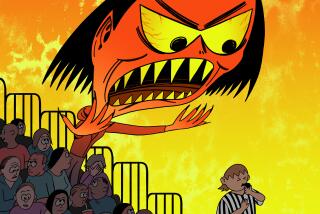Raw, Raw Facts of Cheerleading: The Whole System Is Calling Out for C-H-A-N-G-E
- Share via
My last column on cheerleading elicited so much voice mail and e-mail from readers that I want to share some of their impassioned responses.
If any schools out there thought their problems with cheerleading were unique, I can assure them they are not. The stories of woe would fill this entire page. Here’s a sampling.
One high school principal confided that dealing with cheerleading is his worst nightmare. He added that there had been six faculty advisors in seven years and that no teacher would take on the task this year.
Teacher advisors came forward with “war stories” that covered a wide range of abuses: being yelled at by parents during games; having a cheerleader’s grades changed as a result of a parental complaint; putting up with rude, inappropriate behavior on the part of nonfaculty “walk-on coaches”; receiving hate mail; kicking a girl off the team for a serious infraction and then having her reinstated by the administration; and being pressured to take the job of cheerleader advisor in order to get a teaching position.
Some of the most heartbreaking stories came from parents of cheerleaders, a group whose members often are divided among themselves. All of those parents requested anonymity because they feared the consequences that “going public” would have on their children, a sad statement in itself. To object to anything, they all insisted, would result in their being labeled “overprotective” and their children being called “wimps.” Even injuries as serious as stress fractures, bruises to the head and being knocked unconscious are no grounds for complaining.
Several parents had serious concerns about the huge amounts of money involved and the way that money is managed. Some report large sums going to walk-on coaches who have no expertise or training other than the fact they were once cheerleaders themselves. Others claim money collected as a “tax deductible” donation winds up in someone’s pocket. Fund-raising often is done on an individual basis, with the “poorer” families having to raise more.
Perhaps the most upsetting testimonies concerned the physical and emotional damage this activity is causing far too many young people. The worst examples again involve abuses by walk-on coaches, who in most cases have no training in first aid or CPR, let alone how to work effectively with teens. Examples poured in of coaches taunting kids, bringing them to tears, pushing them to do stunts beyond their physical abilities, asking embarrassing questions about their weight, and creating a damaging, overly competitive atmosphere as opposed to a cooperative, nurturing one. As one mother simply put it: “They cause so much heartache.”
As for solutions, the respondents came forward with a lot of ideas, including several who suggested doing away with cheerleading completely. Short of that extreme, they proposed other possibilities:
* Reduce the amount of money that is spent on cheerleading and stick to the amount that is set. Move to less expensive outfits, or even have a permanent set of uniforms in varying sizes that stay with the school. Cut back on the many “extra” expenses that surround cheerleading, such as competition fees and food for male athletes.
* Consider dropping the competitive side of cheerleading, which has nothing to do with school spirit, and, related to that, overreliance on technically demanding stunts as opposed to creative dance. Or create two distinct teams: one that cheers at games and one that competes as a gymnastics group.
* See that walk-on cheerleading coaches have safety training and classes designed to address the psychological-emotional side of dealing with teenagers. Limit professional coaching to competitive teams only.
* Discuss the role of booster clubs or whether they’re needed at all. At least see that booster clubs work in close contact with the school in regard to finances and the degree of influence that is appropriate. As one activities director put it: “Boosters should support the activity, not run it.”
The people who made those suggestions are obviously concerned, bright, caring administrators, teachers and parents. Surely they can put their heads and hearts together and start the ball rolling. But it is unlikely that one school can change things by itself because of the competitive nature of the situation. This has to be a concerted effort involving entire districts, leagues or associations.
If everyone can agree to a set of reasonable, fair guidelines, then no school is penalized for trying to introduce a kinder, gentler system. There are probably as many solutions to this current mess as there are schools, but maintaining the status quo certainly isn’t one of them.
Christine Baron is a high school English teacher in Orange County. You may reach her at educ@latimes.com or (714) 966-4550.






